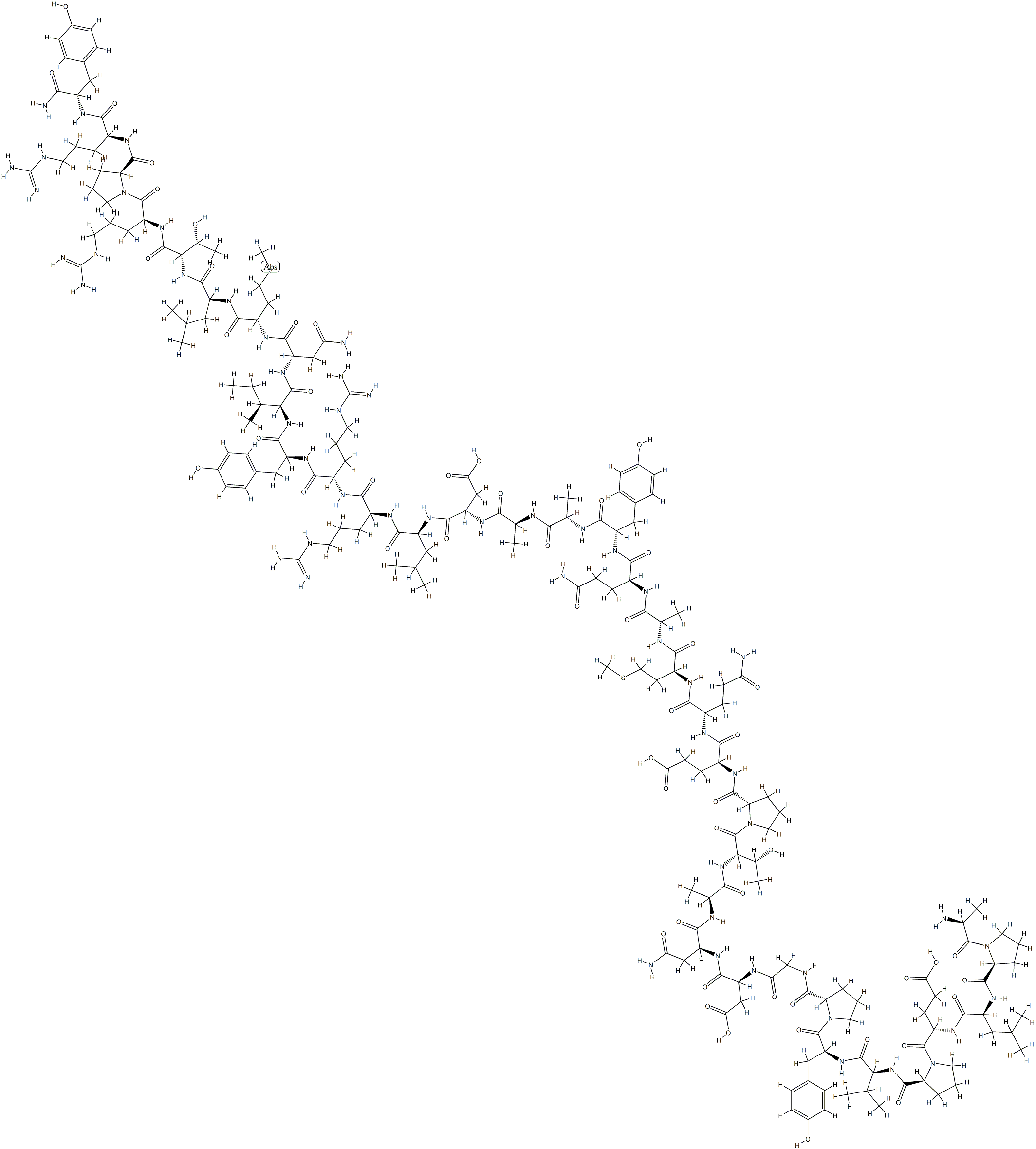PANCREATIC POLYPEPTIDE, HUMAN
- CAS No.
- 75976-10-2
- Chemical Name:
- PANCREATIC POLYPEPTIDE, HUMAN
- Synonyms
- PP, HUMAN;PANCREATIC POLYPEPTIDE;Human pancreatic polypeptide;PANCREATIC POLYPEPTIDE, HUMAN;M.W. 4181.71 C185H287N53O54S2;Pancreatic polypeptide(human) (9CI);PANCREATIC POLYPEPTIDE, HUMAN USP/EP/BP;APLEPVYPGDNATPEQMAQYAADLRRYINMLTRPRY-NH2;Pancreatic Polypeptide human, ≥95% (HPLC);Pancreatic Polypeptide huManPancreatic Polypeptide
- CBNumber:
- CB6764364
- Molecular Formula:
- C185H287N53O54S2
- Molecular Weight:
- 4181.71098
- MDL Number:
- MFCD00081812
- MOL File:
- 75976-10-2.mol
PANCREATIC POLYPEPTIDE, HUMAN price More Price(7)
| Manufacturer | Product number | Product description | CAS number | Packaging | Price | Updated | Buy |
|---|---|---|---|---|---|---|---|
| Cayman Chemical | 24555 | Pancreatic Polypeptide (human) ≥95% | 75976-10-2 | 500μg | $305 | 2024-03-01 | Buy |
| ChemScene | CS-0021293 | PancreaticPolypeptide,human | 75976-10-2 | 1mg | $380 | 2021-12-16 | Buy |
| ApexBio Technology | B5060 | PancreaticPolypeptide(human) | 75976-10-2 | 1mg | $646 | 2021-12-16 | Buy |
| ChemScene | CS-0021293 | PancreaticPolypeptide,human | 75976-10-2 | 5mg | $1500 | 2021-12-16 | Buy |
| ApexBio Technology | B5060 | PancreaticPolypeptide(human) | 75976-10-2 | 5mg | $2520 | 2021-12-16 | Buy |
PANCREATIC POLYPEPTIDE, HUMAN Chemical Properties,Uses,Production
Discovery
The pancreatic polypeptide (PP) is a peptide hormone secreted from the pancreas to inhibit pancreatic exocrine secretion, gall bladder contraction, gastric emptying, and gut motility, and to modulate anxiolytic and depressive behaviors. PP was isolated in 1975 as a byproduct of insulin purification from the pancreas.
Structure
Mature PP is a linear peptide consisting of 36 aa residues in mammals, including humans. PP is a member of the neuropeptide Y (NPY) family, and about 50% homology with NPY and 70% homology with peptide YY (PYY) in pigs. The amino acid sequences of PP are conserved in mammals and other nonmammalian specie. Human PP: Mr. 4182. Soluble in water, acid solutions, and methanol.
Gene and mRNA
The human PP gene is localized with the NPY gene on chromosome 17p21.31 and consists of four exons. In humans, preproPP has 95 aa residues, comprising a 29-aa signal peptide, a 36-aa mature PP, and a 30-aa C-terminal peptide. PP gene expression is restricted to the pancreas in the fourth cell type, named F cells. The PP-producing F cells often take up a peripheral position in the islets, and are distinct from the three other major islet cell populations, the insulin-producing β cells, the glucagon-producing α cells, and the somatostatin-producing S cells.
Synthesis and release
A potential AP-1 binding site and several potential AP-2 binding sequences, which are activated by cAMP and phorbol ester, are located upstream of the transcriptional initiation site of the human PP gene. PP is secreted from the F cells of the pancreatic islets. The secretion of PP is increased by protein meal ingestion, fasting, and exercise.
Agonists and antagonists
Agonists and antagonists for the Y4 receptor are discussed in Subchapter 34B.
Biological functions
PP secreted from the pancreas stimulates gastric juice secretion. The peripheral administration of PP decreases food intake in rodents while central administration of PP increases food intake. PP inhibits pancreatic exocrine secretion, gall bladder contraction, gastric emptying, and gutmotility.The peripheral administration of PP causes Y4 receptor-dependent c-Fos expression in the brainstem, hypothalamus, and amygdala. The chronic peripheral administration of PP reduces anxiety.
Clinical implications
Plasma PP levels are reduced following increased food intake, and elevated in anorexia nervosa. PP administration reduces food intake in lean humans as well as in obese patients with Prader-Willi syndrome. No PP-related peptides and compounds have been used clinically as therapeutic agents.
Description
Pancreatic polypeptide is an agonist of neuropeptide Y (NPY) receptors that reduces forskolin-induced cAMP accumulation in L-M(TK-) cells recombinantly expressing human and rat Y4 receptors (EC50s = 87.1 and 36.3 pM, respectively). It binds to Y1 and Y5 receptors with Ki values of 19 and 3.9 nM, respectively, for human and 50 and 2.4 nM, respectively, for rhesus monkey receptors. Pancreatic polypeptide also binds to rabbit Y1, Y2, Y4, and Y5 receptors (Kis = 0.39, 0.087, 0.79, and 0.24 nM, respectively). It induces contractile responses in isolated rat colon with EC50 values of 1.6 and 0.7 nM for ascending and descending colon segments, respectively. In vivo, pancreatic polypeptide (0.7-7 nmol, i.c.v.) increases food intake in rats.
Clinical Use
PP secretion from the pancreas in response to vagal nerve stimulation has been used as a diagnostic test of vagal nerve function.
storage
Store at -20°C
PANCREATIC POLYPEPTIDE, HUMAN Preparation Products And Raw materials
Raw materials
Preparation Products
PANCREATIC POLYPEPTIDE, HUMAN Suppliers
| Supplier | Tel | Country | ProdList | Advantage | |
|---|---|---|---|---|---|
| Shenzhen Nexconn Pharmatechs Ltd | +86-755-89396905 +86-15013857715 | admin@nexconn.com | China | 10310 | 58 |
| Cellmano Biotech Limited | 0551-65326643 18156095617 | info@cellmano.com | China | 999 | 58 |
| Dideu Industries Group Limited | +86-29-89586680 +86-15129568250 | 1026@dideu.com | China | 22883 | 58 |
| BOC Sciences | 16314854226; +16314854226 | inquiry@bocsci.com | United States | 19741 | 58 |
| Zhejiang J&C Biological Technology Co.,Limited | +1-2135480471 +1-2135480471 | sales@sarms4muscle.com | China | 10473 | 58 |
| Chengdu Youngshe Chemical Co., Ltd. | +8618108235634 | Cecilia@youngshechem.com | China | 2345 | 58 |
| TargetMol Chemicals Inc. | support@targetmol.com | United States | 38632 | 58 | |
| Nanjing TGpeptide | +86-13347807150 +86-13347807150 | support@tgpeptide.com | China | 3279 | 58 |
| Zhejiang Hangyu API Co., Ltd | +8617531972939 | anna@api-made.com | China | 2943 | 58 |
| Changsha MOL Changes Biotechnology Co., Ltd. | +8619375158599 | info@molchanges.com | China | 5225 | 58 |
75976-10-2(PANCREATIC POLYPEPTIDE, HUMAN)Related Search:
1of4





